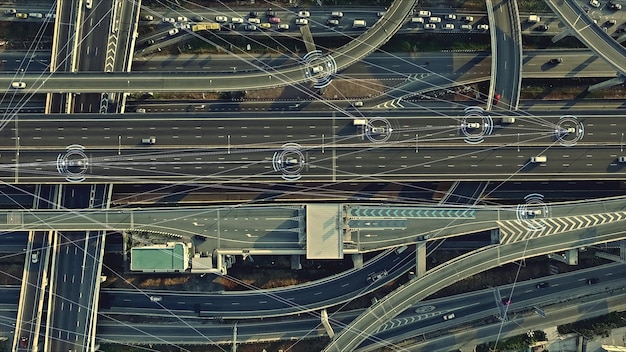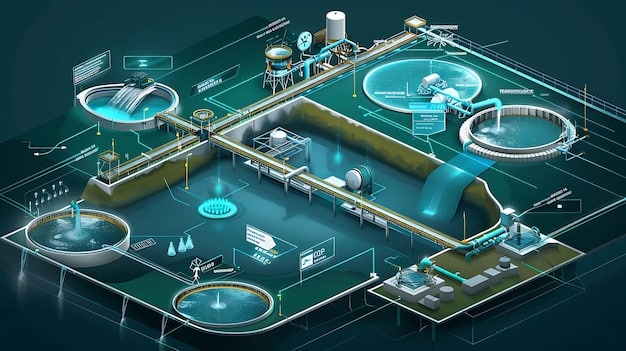US Infrastructure Development: A Look at the $1.2 Trillion Investment Plan

The US Infrastructure Development: A Look at the $1.2 Trillion Investment Plan represents a monumental effort to modernize America’s aging infrastructure, aiming to bolster economic competitiveness, enhance public safety, and create millions of jobs across various sectors.
The landscape of the United States, marked by sprawling highways, intricate public transit systems, and vast utility networks, reflects decades of development. However, the wear and tear of time, coupled with evolving technological demands and environmental challenges, have underscored a pressing need for substantial upgrades. This context sets the stage for a critical examination of the US Infrastructure Development: A Look at the $1.2 Trillion Investment Plan, a landmark legislative effort designed to revitalize the nation’s foundational systems.
The Bipartisan Infrastructure Law: A Historic Commitment
The Bipartisan Infrastructure Law (BIL), also known as the Infrastructure Investment and Jobs Act (IIJA), signifies a pivotal moment for America’s infrastructure. Signed into law in November 2021, this legislation committed an unprecedented $1.2 trillion towards a wide array of infrastructure projects over five years, with approximately $550 billion representing new federal investments. This historic commitment aims to address long-standing deficiencies, stimulate economic growth, and position the U.S. for future prosperity.
The roots of this investment can be traced back to growing concerns over the deteriorating state of American infrastructure. For years, reports from organizations like the American Society of Civil Engineers (ASCE) have consistently graded the nation’s infrastructure poorly, highlighting critical needs across categories such as roads, bridges, transit, water pipes, and electricity grids. The economic implications of this decay are significant, impacting supply chains, increasing maintenance costs, and hindering overall productivity. The BIL emerged as a bipartisan solution to these pressing issues, reflecting a consensus that infrastructure investment is not merely an expenditure but a strategic economic necessity.
Key Pillars of the Investment
The $1.2 trillion plan is structured around several core pillars, each targeting specific areas of infrastructure. These pillars are designed to be interconnected, fostering a comprehensive approach to modernization. The primary focus areas include:
- Transportation: Allocating significant funds for roads, bridges, public transit, passenger rail, airports, and ports. This aims to improve mobility, reduce congestion, and enhance safety.
- Water Infrastructure: Investing in safe drinking water, wastewater systems, and addressing lead pipe replacement. This ensures public health and environmental protection.
- Broadband Internet: Expanding access to high-speed internet, especially in underserved rural and low-income areas. This addresses the digital divide and supports remote work and education.
- Power Grid: Modernizing the nation’s electric grid, including investments in clean energy transmission and resilience against extreme weather events. This is crucial for energy security and sustainability.
- Resilience: Funding projects to protect communities from natural disasters, cyberattacks, and climate change impacts. This proactive approach strengthens national security and public safety.
Beyond these broad categories, the law also earmarks funds for environmental remediation, electric vehicle charging infrastructure, and addressing legacy pollution sites. The scope of the bill is expansive, touching nearly every aspect of daily life and economic activity. Its implementation presents both immense opportunities for national improvement and considerable challenges in terms of coordination, workforce development, and ensuring equitable distribution of resources. Understanding these foundational elements is crucial to appreciating the potential impact of this historic infrastructure investment.
Roads, Bridges, and Public Transit: Repairing the Lifeline
A significant portion of the $1.2 trillion investment is dedicated to the arteries of America: its roads, bridges, and public transit systems. For decades, these critical components of the national infrastructure have suffered from underinvestment, leading to deteriorating conditions that impact commuters, commerce, and safety. The Bipartisan Infrastructure Law aims to reverse this trend, allocating substantial resources to repair, rebuild, and modernize these essential networks.
Roads and bridges, in particular, are central to the nation’s economy and daily life. Millions of miles of roads facilitate the movement of goods and people, while over 600,000 bridges connect communities and supply chains. The ASCE’s 2021 Infrastructure Report Card gave U.S. roads a ‘D’ and bridges a ‘C,’ indicating pervasive deficiencies. Potholes, crumbling asphalt, and structurally deficient bridges not only lead to higher vehicle maintenance costs but also contribute to traffic delays and safety hazards.
Targeted Investments and Expected Outcomes
The law provides approximately $110 billion for roads, bridges, and major projects. This funding is designed to address the backlog of repairs and upgrades nationwide. State and local governments will receive the bulk of these funds, empowering them to prioritize the most critical projects in their jurisdictions. The expected outcomes are multifaceted:
- Improved Safety: Modernizing outdated road designs and repairing dilapidated bridges is anticipated to significantly reduce accidents and fatalities. Safer roads and bridges mean more secure commuting and transportation of goods.
- Reduced Congestion: Investments in road expansion, intelligent transportation systems, and public transit are expected to ease traffic bottlenecks, leading to faster travel times and more efficient supply chains.
- Economic Efficiency: Less time spent in traffic and fewer vehicle repairs due to poor road conditions translate into substantial economic savings for both businesses and individuals. This efficiency can boost productivity and foster regional economic growth.
- Job Creation: The sheer scale of construction projects will create an estimated hundreds of thousands of jobs in engineering, construction, and related sectors, providing a significant economic stimulus.
Beyond roads and bridges, public transit systems are also receiving a much-needed boost with approximately $39 billion in new investments. Many transit agencies, especially in older cities, operate with aging fleets and infrastructure, leading to reliability issues and limited service. This funding aims to expand transit options, replace old vehicles with cleaner, electric alternatives, and improve the overall rider experience.
The challenge lies in the effective allocation and oversight of these funds. Ensuring projects are completed on time, within budget, and with the greatest possible impact requires robust planning, transparent procurement processes, and strong accountability mechanisms. The repair and modernization of roads, bridges, and public transit are not just about rebuilding physical structures; they are about strengthening the very foundations of American mobility and economic vitality.

Water and Broadband: Essential Services for the 21st Century
In the 21st century, access to clean, safe water and reliable high-speed internet has become as fundamental as electricity. The Bipartisan Infrastructure Law recognizes this imperative, allocating significant investments to modernize water infrastructure and bridge the persistent digital divide. These two sectors are crucial for public health, economic equity, and overall societal well-being.
America’s water infrastructure, much like its transportation networks, is aging. Numerous communities still grapple with lead service lines, antiquated wastewater treatment systems, and vulnerability to contaminants. The result: public health risks, environmental degradation, and a lack of trust in vital services. The BIL commits an unprecedented $55 billion to water infrastructure, marking the largest-ever investment in safe drinking water in U.S. history.
Revolutionizing Water Systems
The water provisions within the law target several key areas:
- Lead Pipe Replacement: A substantial portion of the funding is dedicated to replacing lead service lines, addressing a pervasive health hazard that disproportionately affects low-income communities and communities of color. This measure is expected to significantly improve public health outcomes.
- Clean Water State Revolving Fund: This fund will see a massive infusion of capital, enabling states to finance projects that improve wastewater treatment, manage stormwater runoff, and reduce pollution.
- Drinking Water Infrastructure: Investments will also flow into upgrading water treatment plants, repairing aging pipes, and enhancing the resilience of water systems against natural disasters and climate change.
These investments are paramount for public health, ensuring that every American has access to clean and safe drinking water. They also contribute to environmental protection by reducing water pollution and safeguarding aquatic ecosystems. The long-term benefits include reduced healthcare costs, improved quality of life, and enhanced environmental sustainability.
Parallel to water, broadband internet has transitioned from a luxury to an absolute necessity. The COVID-19 pandemic starkly illuminated the digital divide, highlighting how millions of Americans, particularly in rural and low-income urban areas, lack access to affordable, high-speed internet. This limits opportunities for education, employment, healthcare (telemedicine), and civic participation.
The BIL earmarks $65 billion to expand broadband access across the nation. This significant investment aims to deliver affordable and reliable internet to every household, ensuring no community is left behind in the digital age. The funding will largely be distributed to states to implement their own broadband expansion programs, with a focus on prioritizing unserved and underserved areas.
Efforts will also be made to address affordability, with provisions included to help low-income households access subsidized internet services. By ensuring equitable access to high-speed internet, the law aims to unlock new economic opportunities, enhance remote learning capabilities, improve access to healthcare services, and foster greater social connectivity across the country. The integration of these essential services—clean water and broad internet—underscores a holistic approach to building a more resilient, equitable, and prosperous America.
Power Grid and Energy Transition: Building a Resilient Future
The nation’s electrical grid, often called the largest machine in the world, is another critical focus of the Bipartisan Infrastructure Law. America’s grid infrastructure, much of which dates back to the mid-20th century, faces significant challenges from aging components, increasing demand, and escalating threats from severe weather events and cyberattacks. The $1.2 trillion investment plan commits substantial resources to modernize the power grid, enhance its resilience, and facilitate a cleaner energy transition.
The goal is twofold: to ensure reliable and affordable electricity for all Americans, and to accelerate the shift towards renewable energy sources. A resilient grid is not just about avoiding blackouts; it’s about enabling a future powered by clean energy, capable of withstanding the impacts of climate change, and responsive to evolving energy demands.
Modernizing and Securing the Grid
The law allocates approximately $65 billion towards the power grid and energy sector. This funding targets several key areas for improvement:
- Grid Modernization: Investments will go into upgrading transmission and distribution lines, deploying smart grid technologies, and improving grid reliability. This includes measures to prevent outages and enhance the grid’s ability to handle intermittent renewable energy sources.
- Grid Resilience: Funds are earmarked for hardening the grid against extreme weather events (e.g., wildfires, hurricanes, ice storms) and cyberattacks. This involves burying power lines, deploying advanced sensors, and implementing robust cybersecurity protocols.
- Clean Energy Transmission: A significant emphasis is placed on building new transmission lines to carry renewable energy from generation sites (like solar farms and wind farms) to population centers. This is crucial for integrating more clean energy into the national grid and achieving decarbonization goals.
The transition to clean energy is a central theme of the grid investments. By supporting the build-out of new transmission infrastructure, the law directly addresses one of the primary bottlenecks to scaling up renewable energy. Without adequate transmission capacity, clean energy generated in remote areas cannot efficiently reach consumers, thus limiting its widespread adoption.
Furthermore, the law promotes the deployment of energy storage technologies, such as large-scale batteries, which are essential for balancing the variable output of solar and wind power. These investments are key to creating a more flexible and robust energy system that can support a future with a higher penetration of renewables.
The efforts to modernize and secure the power grid are not just about environmental sustainability; they are also about economic competitiveness and national security. A stable and resilient power supply is fundamental to all sectors of the economy, from manufacturing to digital services. By making these strategic investments, the U.S. aims to reduce energy costs, create high-paying jobs in the clean energy sector, and solidify its leadership in the global energy transition, ensuring a reliable and sustainable power future for generations to come.
Climate Resilience and Environmental Justice: Protecting Communities
The Bipartisan Infrastructure Law extends beyond traditional infrastructure to address pressing issues of climate resilience and environmental justice. Recognizing that climate change disproportionately impacts vulnerable communities and that legacy pollution burdens persist, the law includes significant funding to protect communities from natural disasters and remediate contaminated sites. This holistic approach emphasizes the interconnectedness of infrastructure, environment, and social equity.
The increasing frequency and intensity of extreme weather events—from hurricanes and floods to wildfires and droughts—underscore the urgent need for climate-resilient infrastructure. Many existing systems were not built to withstand the current realities of a changing climate, leading to devastating economic losses and human suffering. Simultaneously, the legacy of industrial pollution has left many low-income communities and communities of color with elevated health risks and limited economic opportunities.
Investing in a Safer, Healthier Future
The law directs substantial funding towards projects that enhance resilience and address environmental injustices:
- Climate Resilience Programs: Funds are allocated to mitigate the impacts of floods, wildfires, and droughts. This includes investments in coastal restoration, levee improvements, early warning systems, and forest management to reduce wildfire risks.
- Water Infrastructure Resilience: Beyond basic water quality, the law supports projects that harden water systems against climate change impacts, such as sea-level rise and extreme rainfall, ensuring continued access to safe water.
- Brownfield and Superfund Site Clean-up: Significant investment is directed towards cleaning up polluted industrial sites (brownfields) and hazardous waste sites (Superfund sites). This remediation reduces public health risks, reclaims contaminated land, and stimulates economic revitalization in affected areas.
- Orphaned Well Clean-up: The law provides funding to plug and remediate orphaned oil and gas wells, which are abandoned wells that leak methane (a potent greenhouse gas) and pollute groundwater. This addresses a significant environmental and health hazard, particularly in rural communities.
These investments represent a concerted effort to shift from reactive disaster response to proactive risk reduction and adaptation. By building more resilient infrastructure, communities can better withstand the shocks of a changing climate, minimizing disruptions and protecting lives and property. This also fosters economic stability by safeguarding vital assets and supply chains.
Moreover, the emphasis on environmental justice is critical. For too long, marginalized communities have borne a disproportionate share of environmental burdens. By dedicating resources to clean up polluted sites and replace lead pipes in these areas, the law aims to rectify historical inequities and promote a healthier, more equitable future. This includes engaging community input in project selection and ensuring that the benefits of new infrastructure are broadly shared.
The provisions for climate resilience and environmental justice within the Bipartisan Infrastructure Law underscore a commitment to building a more sustainable and just future. They recognize that infrastructure serves not only economic functions but also plays a vital role in protecting public health, safeguarding the environment, and fostering social equity across the nation. This integrated approach is essential for long-term national well-being and resilience.
Economic Impact and Job Creation: Fueling America’s Future
Beyond the immediate improvements to physical infrastructure, one of the most compelling arguments for the $1.2 trillion investment plan is its anticipated economic impact and capacity for job creation. Proponents argue that strategic infrastructure spending is a powerful engine for economic growth, generating jobs, boosting productivity, and enhancing America’s global competitiveness. The Bipartisan Infrastructure Law is poised to deliver significant benefits across various sectors, touching every corner of the U.S. economy.
Infrastructure projects are inherently labor-intensive, requiring a diverse range of skills and trades. From engineers and construction workers to truck drivers and material suppliers, a wide array of professions will be engaged in the planning, execution, and maintenance of these projects. This direct job creation is then amplified by indirect and induced effects throughout the economy, as wages are spent and supply chains stimulated.
Multipliers of Prosperity
The economic benefits of infrastructure investment are well-documented. Studies often point to a “multiplier effect,” where every dollar invested in infrastructure generates several dollars in economic activity. The expected economic benefits from the BIL include:
- Millions of Jobs: The Biden administration estimates the law will create an average of 1.5 million jobs per year over the next decade. These jobs are expected to be good-paying, often unionized positions, providing stable employment opportunities.
- Increased Productivity: Modernized infrastructure leads to efficiencies. Smoother roads, faster internet, and reliable power grids reduce transportation costs, support remote work, and enable technological advancements, all of which contribute to higher productivity across industries.
- Enhanced Competitiveness: A strong infrastructure backbone improves the flow of goods and services, making American businesses more competitive globally. Efficient supply chains and advanced digital connectivity are crucial for attracting foreign investment and expanding domestic industries.
- Long-Term Economic Growth: By laying the foundation for future economic activity, infrastructure investments are not just a short-term stimulus but a long-term strategy for sustainable growth. They lower the cost of doing business and create new opportunities for innovation.
Furthermore, the focus on specific areas such as clean energy transmission and electric vehicle charging infrastructure is expected to catalyze growth in emerging sectors, positioning the U.S. as a leader in the global clean energy transition. The demand for materials, equipment, and skilled labor will create ripples throughout the manufacturing sector, benefiting producers of steel, concrete, fiber optic cables, and renewable energy components.
However, realizing these benefits requires careful management of the workforce. Ensuring that there are enough skilled workers to meet the demands of hundreds of thousands of new projects is a significant challenge. Investments in workforce development programs, apprenticeships, and vocational training will be crucial to maximize the job creation potential of the law and ensure that new opportunities are accessible to all Americans. The Bipartisan Infrastructure Law represents a substantial commitment to revitalizing America’s infrastructure, designed not only to fix what is broken but also to ignite economic growth and build a more prosperous future for the nation.
Challenges and Implementation: Navigating the Road Ahead
While the $1.2 trillion investment plan heralds a new era of infrastructure development in the U.S., its ambitious scope naturally brings forth a myriad of challenges in its implementation. Transforming legislative intent into tangible projects on the ground requires meticulous planning, effective coordination, and overcoming various hurdles that range from bureaucratic complexities to workforce shortages. The success of the Bipartisan Infrastructure Law hinges critically on how these challenges are addressed.
One of the primary concerns revolves around the sheer scale and complexity of the projects. Infrastructure development often involves multiple stakeholders, including federal, state, and local governments, private contractors, labor unions, and local communities. Coordinating these diverse interests and ensuring alignment on priorities and execution timelines can be a formidable task. Permitting processes, environmental reviews, and procurement procedures can be lengthy and intricate, potentially delaying project starts and increasing costs.
Obstacles to Overcome
Several key challenges stand out:
- Supply Chain Disruptions and Inflation: Global supply chain issues and rising inflation could impact the cost and availability of materials needed for construction. This could lead to budget overruns and delays, potentially diminishing the overall impact of the investment.
- Workforce Shortages: America faces a persistent shortage of skilled construction workers, engineers, and tradespeople. The demand created by the infrastructure bill could exacerbate this issue, making it difficult to staff projects and drive up labor costs.
- Equitable Distribution: Ensuring that funds are distributed equitably across states and communities, particularly to those most in need or historically underserved, requires careful oversight and avoids political favoritism.
- Project Selection and Prioritization: Deciding which projects get funded and in what order requires robust needs assessments, transparent decision-making processes, and balancing national priorities with local needs.
- Cybersecurity Risks: Modernizing critical infrastructure, especially the power grid and broadband networks, increases its digital footprint and potentially its vulnerability to cyberattacks. Protecting these systems from malicious actors is an ongoing challenge.
Addressing these challenges requires a concerted effort from all levels of government and collaboration with the private sector. Streamlining permitting processes, where appropriate, can accelerate project timelines without compromising environmental standards. Investing in workforce development programs, apprenticeships, and vocational training is essential to build the skilled labor force required for these projects. Furthermore, proactive engagement with local communities will be vital to ensure projects meet their needs and minimize disruptions.
Transparency and accountability are also paramount. Regular reporting on project progress, budget adherence, and job creation metrics will be crucial to maintain public trust and justify the significant investment. The Biden administration has established task forces and implemented strategies to monitor the progress of projects and address potential bottlenecks. While the journey ahead will undoubtedly have its bumps, successfully navigating these implementation challenges is critical for the long-term success of the US Infrastructure Development Plan and for America’s future prosperity and competitiveness.
| Key Area | Brief Description |
|---|---|
| 🏗️ Roads & Bridges | Massive investment to repair and upgrade aging transportation networks, improving safety and efficiency. |
| 💧 Water & Broadband | Historic funding for clean drinking water, lead pipe replacement, and expanding high-speed internet access nationwide. |
| ⚡ Power Grid Modernization | Upgrading the electric grid for resilience against outages, cyberattacks, and to support clean energy transition. |
| 🌿 Climate Resilience | Funding for protecting communities from extreme weather and remediating environmental hazards for healthier living. |
Frequently Asked Questions about US Infrastructure Development
▼
The total investment outlined in the Bipartisan Infrastructure Law is $1.2 trillion over five years. Approximately $550 billion of this amount represents new federal spending, while the remainder is reauthorized existing spending and other funds, all directed towards vital infrastructure upgrades across the United States to enhance economic competitiveness and public safety.
▼
The primary focus areas include significant investments in roads, bridges, and public transit to improve mobility; modernizing water infrastructure to ensure safe drinking water and replace lead pipes; expanding access to high-speed broadband internet; upgrading and securing the nation’s power grid; and investing in climate resilience and environmental justice initiatives to protect communities from natural disasters and pollution.
▼
The plan is projected to create an average of 1.5 million jobs per year over the next decade. These jobs will primarily be in sectors like construction, engineering, manufacturing, and related supporting industries. The investments will stimulate demand for skilled labor and materials, leading to direct and indirect job creation across the entire U.S. economy, boosting workforce development.
▼
The infrastructure plan allocates $65 billion to expand high-speed internet access, particularly targeting unserved and underserved rural and low-income areas. The goal is to ensure every American household has access to affordable and reliable broadband, thereby closing the digital divide and enabling better opportunities for education, healthcare, and economic participation in the digital age.
▼
The plan includes substantial funding for climate resilience, aiming to protect communities from extreme weather events like floods and wildfires. It also addresses environmental justice by investing in the cleanup of Superfund sites, brownfields, and orphaned wells, and replacing lead pipes, which disproportionately affect marginalized communities. This aims to create healthier, cleaner environments for all Americans.
A Foundation for America’s Future
The $1.2 trillion investment in U.S. infrastructure represents more than just a financial allocation; it embodies a strategic commitment to strengthening the nation’s foundational systems for decades to come. By addressing critical needs in transportation, water, broadband, energy, and climate resilience, the Bipartisan Infrastructure Law aims to not only repair what is broken but also lay the groundwork for a more competitive, sustainable, and equitable future. While challenges in implementation are inevitable, the potential for economic growth, job creation, and improved quality of life underscores the transformative potential of this historic plan. Its success will ultimately be measured by its ability to deliver tangible benefits to communities across America, ensuring a resilient and prosperous future for all its citizens.





